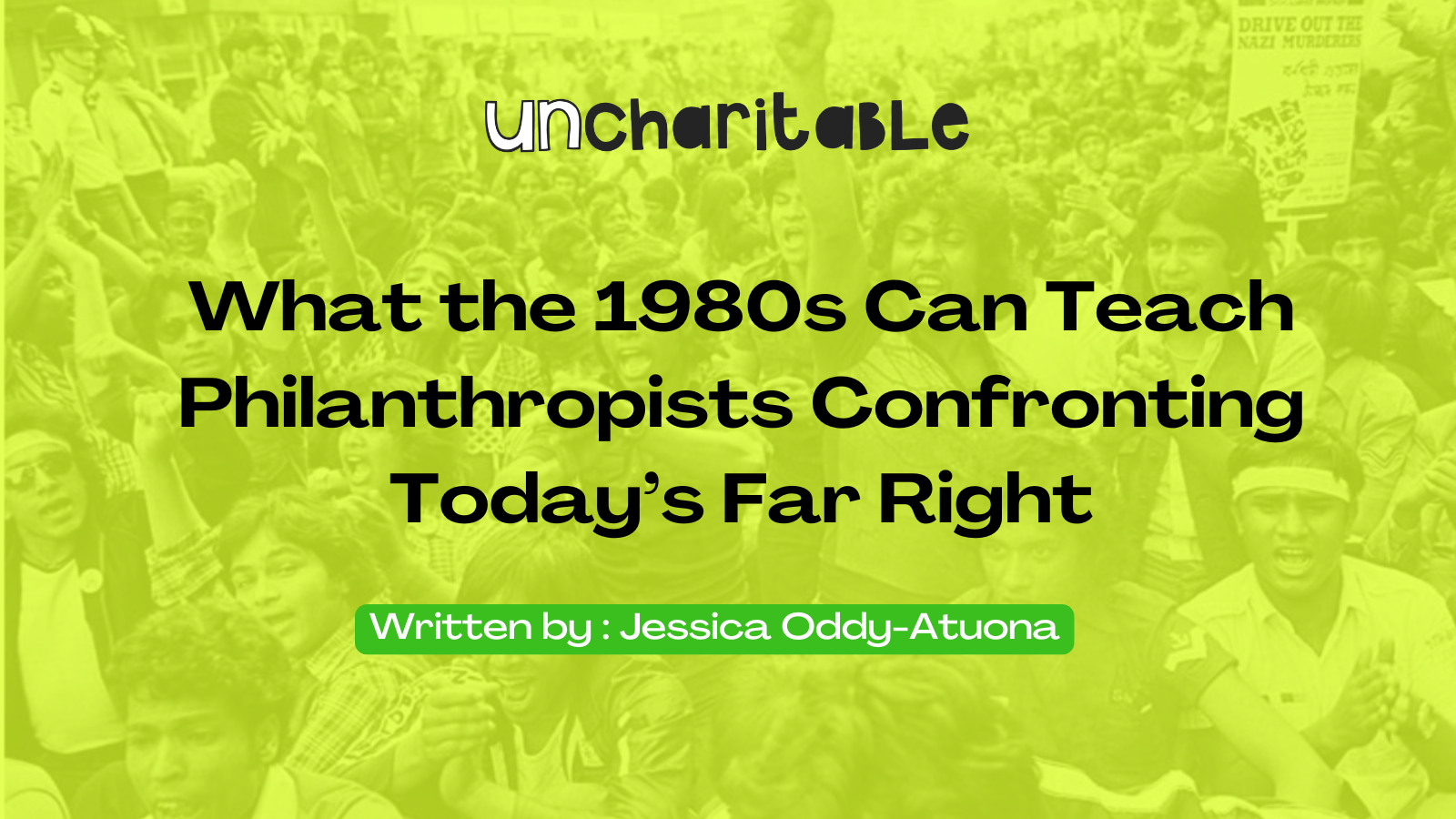What the 1980s Can Teach Philanthropists Confronting Today’s Far Right By Jessica Oddy-Atuona
Paul Trevor, Outside police station, Bethnal Green Road, London E2, 17 July 1978. Credit: Paul Trevor © 2023
Jess has worked in the social impact/third sector for around 15 years. In 2021, she founded a social enterprise, Design for Social Impact, to champion equity-centered, anti-oppressive, evidence-based programs, policies, and research, with a focus on co-design and structural change.
I've been thinking about how we're funding responses to rising extremism. Are we addressing symptoms or causes? A recent exhibition got me reflecting on what the 1980s can teach today's funders about solidarity-based solutions.
Earlier this year, visiting the "80s: Photographing Britain" exhibition at the Tate, I was struck by two things. First, the 1980s were truly terrifying times for structurally marginalised communities in the UK—race uprisings, miners' strikes, Section 28, the AIDS epidemic, and the beginnings of aggressive gentrification painted a picture of a nation in crisis.
Second, it was a decade of unprecedented protest. Poll tax riots, miners' strikes, Brixton and Toxteth uprisings. People were angry, and they were on the streets.
Today, there are many similarities to the 1980s. From monthly pro-Palestine marches filling UK cities since October 2023 to recent far-right counter-demonstrations, people are mobilising. But extremist recruitment now cuts across all demographics - from affluent suburbs where conspiracy theories spread through WhatsApp groups to university-educated professionals drawn to pseudoscientific theories about race and IQ or "civilizational clash" narratives, alongside the working-class communities and as Amhara Spence writes poor, white folks that have long felt abandoned by the system.
But there are crucial differences: the scale and speed of radicalisation enabled by social media, sophisticated far-right messaging reaching from street corners to Silicon Valley boardrooms, and the perfect storm created by COVID-19 lockdowns. Perhaps most critically, the absence of clear opposition to far-right rhetoric from mainstream political parties. Unlike the 1980s when there were starker ideological divisions, today's political landscape sees mainstream politicians often adopting or legitimising far-right talking points rather than challenging them.
The Digital Difference
During lockdowns, people spent unprecedented time online, isolated from community structures that might have provided alternative perspectives. Conspiracy theories flourished—from QAnon to anti-vaccine movements to "great replacement" theory. Health anxiety morphed into something darker as algorithms fed increasingly extreme content and echo chambers replaced real-world community.
Yet there's another crucial difference: today, we have organised philanthropy. Billions sit in foundations and trusts that could address root causes of our current crisis. In the 1980s, communities relied almost entirely on their own resources and mutual aid. Today, we have potential for resourced solidarity, if we're brave enough to deploy it properly.
But let me be clear: I'm not upholding philanthropy as a saviour. Philanthropy itself is part of the problem—built on wealth accumulated through exploitation, often serving as a tool for tax evasion, and historically rooted in colonial extraction. The very structures that created the inequalities fuelling extremism also created philanthropic wealth.
Much of this wealth remains locked in traditional funding models that aren't fit for combating far-right extremism and the social fractures it exploits. This must change, especially as the far-right increasingly attracts some of the wealthiest people on the planet. As Nova Reid recently pointed out, in a 2023 article in Open Democracy, it was reported that 600 grants were given to 36 far-right organisations over a 3 year period from 2017-2020. They understand infrastructure building. We need to as well.
The 1980s offer a blueprint.
Beyond Trust-Based: The Case for Truth-Based Philanthropy
The sector has made huge strides toward "trust-based philanthropy"—reducing bureaucracy, offering multi-year funding, giving grantees autonomy. This is progress, but doesn't go far enough. We need models that go further. Two recent reports offer just this- Right Relations Collaborative 2025 Reciprocity Report calls for "truth-based philanthropy": funding that acknowledges uncomfortable realities about how we got here and what it takes to get out. Grassroots International calls for redefining philanthropy's role in supporting social movements and promoting social, economic, and ecological justice through a framework of solidarity philanthropy towards funding social justice movements.
Because the truth: decades of disinvestment in political education, community infrastructure, and spiritual wellbeing have created fertile ground for extremism. And philanthropy has been complicit—hoarding wealth that should have been redistributed, funding palatable projects over radical change, and maintaining power structures that perpetuate inequality. When people feel economically precarious, socially isolated, and spiritually empty, they become vulnerable to narratives offering simple explanations and convenient scapegoats.
This isn't just theory for me. Growing up working-class, I watched community centres close and youth services slashed. The informal networks holding neighbourhoods together frayed. Working in nonprofits later, I saw how funding decisions—made far from affected communities, contributed to this hollowing out. We funded symptoms, not causes. Food banks instead of advocacy initiatives for living wages. Crisis response instead of prevention.
What if progressive philanthropy, despite its contradictions, funded the infrastructure that prevents extremism from taking root?
Funding the Drivers, Not Just Outcomes
My understanding is that truth - or solidarity-based philanthropy - requires funding work that addresses drivers of far-right extremism, even when uncomfortable:
Political Education: The far-right filled the void left by our failure to engage people in meaningful political education. While fascists offer simple narratives, arguably progressive movements often retreat into alienating jargon. We need grassroots political education meeting people where they are—using accessible language to explain how power actually works, drawing from popular education traditions.
Community Infrastructure: Strong communities are the best defence against extremism. When people have meaningful relationships, shared purpose, and collective agency, they resist divisive narratives. This means funding unglamorous community building: resident associations, community gardens, sports clubs, informal networks bringing people together across difference. Places where people know neighbours and have functioning organisations hold together when others fall apart.
Spiritual Practice and Meaning-Making: Perhaps the most overlooked element. Humans need meaning, purpose, connection to something greater. When traditional sources—religion, community, stable work erode without replacement, people become vulnerable to toxic ideologies offering belonging. Now this doesn't mean only funding religious organisations. It means supporting secular practices nurturing human spirit: arts programmes helping to process trauma and imagine better futures, mindfulness training, storytelling circles helping communities make sense of experiences.
Learning from 1980s Solidarity
The 1980s offer powerful lessons about solidarity in practice. Communities under attack didn't just protest, they built alternatives. Black communities created supplementary schools when education failed their children. LGBTQI+ communities developed care networks during AIDS crisis when the state abandoned them. Mining communities organised soup kitchens during strikes.
Consider Southall Black Sisters, formed in 1979 by women from African, Caribbean, and South Asian backgrounds or the Organisation of Women of African and Asian Descent (OWAAD), which brought together Black and Asian women across different backgrounds to build solidarity across racial and cultural lines. Similarly, LGBTI+ groups like Lesbians and Gays Support the Miners built unexpected alliances, while anti-apartheid campaigns brought together activists across racial and class lines around shared opposition to injustice.
These weren't charity helping "deserving poor"—they recognised shared struggles against oppression, building power together across difference. This is solidarity-based philanthropy: funding that recognises our interconnection, that injustice anywhere threatens justice everywhere.
Here's what this looks like in practice for today's funders:
The Stakes Are Higher Now
Today's philanthropists must ask: Are we funding charity or justice? Maintaining the status quo or supporting fundamental change?
The far-right has wealthy backers and sophisticated infrastructure. They're funding political education (albeit toxic), building community (albeit exclusionary), and offering meaning (albeit destructive). They understand what we often miss: people need more than material support—they need purpose, belonging, and hope.
A Call to Strategic Action
The far-right didn't emerge overnight and won't be defeated overnight. But we have resources previous generations could only dream of. Given philanthropy's complicity in creating these conditions, we have a responsibility to use these resources radically differently:
Fund across all communities where extremist narratives take hold - recognising this isn't just a "working-class problem" but affects middle-class suburbia, university campuses, and online spaces where educated professionals can be radicalised through seemingly respectable channels. In today's climate where DEI initiatives face coordinated attack, double down on racial justice work—but strategically, supporting organisations reframing equity in language building broader coalitions.
Back rigorous research countering disinformation. Support media literacy helping people critically analyse information and recognise algorithmic manipulation. Fund digital detox and community connection initiatives rebuilding real-world relationships.
Invest in infrastructure bringing people together across difference and class lines. Support spiritual practices offering meaning without hate. Fund the unglamorous work of democracy: civic education, community organising, local journalism.
For large national NGOs: Stop competing for the same pots of money while communities burn. The 1980s showed us that solidarity beats charity every time. Instead of protecting organisational territory, build genuine partnerships with grassroots groups. Share resources, platforms, and power. Your brand recognition and policy access mean nothing if you're not connected to communities experiencing the sharp end of extremism.
For grassroots organisations: don't water down politics for funding. The stakes are too high for compromise. Make the case for addressing root causes over band-aid solutions. And to the big NGOs reading this—you need grassroots partners more than they need you.
The Choice Before Us
The 1980s taught us ordinary people can resist extraordinary oppression when they unite in solidarity. We can use these resources, however problematically accumulated, to fund radical change rather than preserve power. The question is whether we'll learn this lesson before it's too late.
The money exists. Strategies exist. What we need is will to act. Not with charity, but solidarity. Not just with trust, but truth.
The streets are full again. For those of us with resources to deploy—whether as foundation trustees, grant-makers, or individual donors—we must ask ourselves: are we funding the right side of history?

